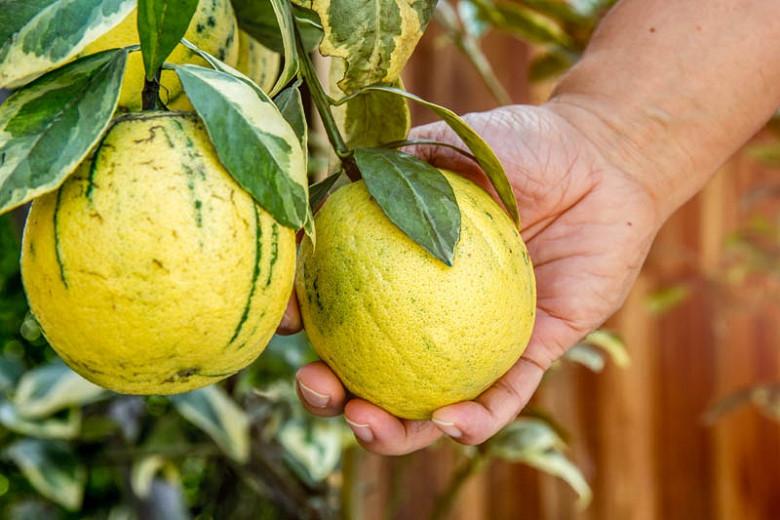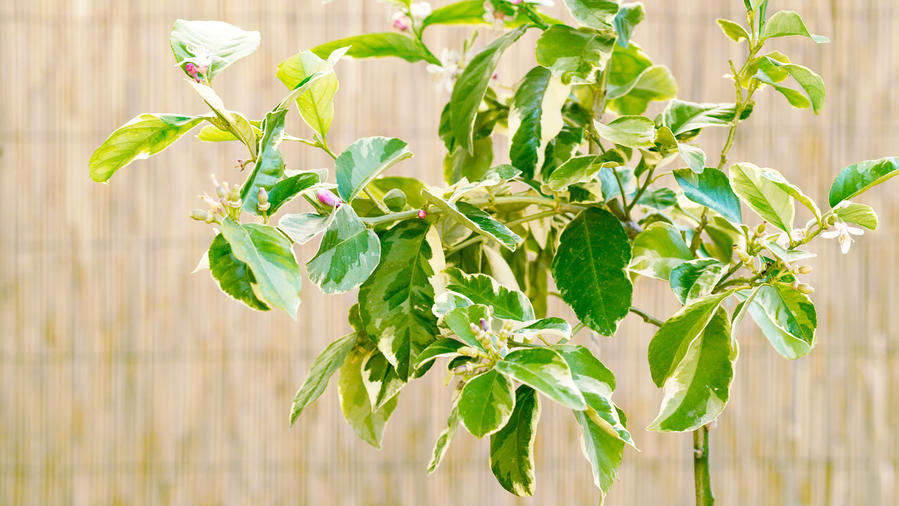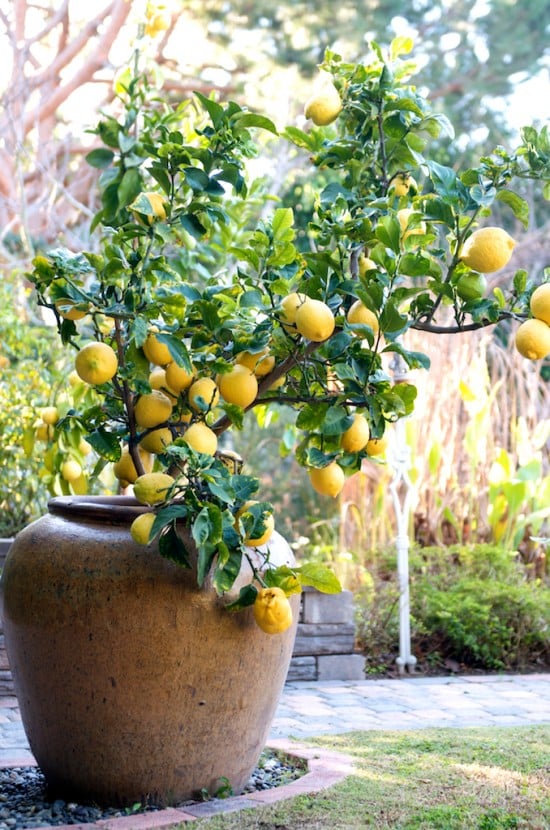The Eureka pink lemon tree goes by many names. For instance;
- The variegated Eureka lemon
- Pink-fleshed Eureka lemon
- The pink lemonade lemon
It is a cultivar of lemon with pink flesh, a green-striped rind when ripe. In addition to the stripped rind, the eureka pink lemon tree leaves are stripped too.
Eureka Pink Lemon Facts

The pink lemonade lemon was first discovered as a sport on an ordinary Eureka lemon tree in Burbank, California, in 1931.
The eureka pink lemon is versatile in kitchens. It is an ingredient in uncountable recipes from lemonade to lemon cake, pies, and an array of desserts. Fans of this quirky but unusual lemon adore the lemon’s otherworldly beauty and the juicy and citrusy taste.
The eureka pink lemon fruit will make you the best host/hostess during summer cocktail parties because the pink lemons are exotic, unique, and beautiful. The only thing better than having eureka pink limes in your fridge is growing them in your backyard.
How do you grow eureka pink lemons? How do you take care of them? Read on for all the information you need to know about eureka pink lemons and how to grow them.
What is a eureka pink lemon tree?
Variegated pink eureka lemon is an ornamental shrubs tree that will transform the beauty of your landscape, its foliage but even more, its fruit.
The flesh of the lemon looks is pink, but the juice isn’t. It yields a colorless juice with traces of pink and has a mild taste. Older fruits lose the striping, so it’s best to harvest the fruit while young. The pink-colored fruit flesh has few dispersed seeds.
The variegated pi
nk eureka lemon tree is medium-sized citrus that can be grown in a container. It is suitable for gardeners in USDA zones 8 through 11.
How to Grow Variegated Pink Lemon

Eureka pink lemons are often grown from cuttings or by grafting. Alternatively, you can purchase a ready tree and either pot in a growing container or transplant the tree to your garden.
Pink lemons can be grown from the seed, but that is a slow and tedious process that many farmers avoid.
Growing conditions for the eureka pink lemon tree
1. Growing Zone
The pink variegated lemon tree is Hardy to USDA growing zones 8 through 11. Pink lemons, like all other citrus fruits like tropical and warm climates.
If you live in areas with cold or scorching climates, you might want to grow the lemons indoors where you can mimic warm and wet tropical climates.
2. Temperature
Pink lemon trees are sensitive to cold and cannot tolerate temperature below 55 degrees. A temperature lower than 32 degrees is a death sentence to your pink lemon tree.
While you cannot control the temperatures during winter, you can protect your lemon tree from winter frost damage. Many farmers do so using turf insulation blankets around outdoor-grown trees or transferring the potted pink lemon trees indoors ahead of winter.
3. Soil
Eureka pink lemon trees like to grow in well-draining fertile soils. You can use citrus or cactus potting mix or any other potting soil labeled as well-draining to grow eureka pink lemon trees.
If you have garden soil, you can increase or improve the soil’s drainage by mixing perlite and vermiculite in the soil before you plant.
Pink lemon trees cannot stand stagnant water, so good drainage is paramount for the lemons’ healthy growth.
Best care practices for eureka pink lemon tree

1. Water
A farmer needs to water sufficiently and adequately to keep the pink lemon tree hydrated. Watering once or twice a week should suffice unless you live in a hot climate, which you might have to water daily.
It is also crucial for the farmer to never wait for the soil to dry before they water because once the pink lemon tree is left to dry before watering, the dry conditions will shock it and cause damage,
After the plant has gone through water, watering will also add to stress because the lemon roots have sudden access to water, which they didn’t before.
It is important to always water just before the soil loses its moisture. The lemons are always growing in somewhat ever moist soil.
2. Fertilize
It is vital to fertilize a lemon tree with slow-release nitrogen-rich fertilizer at least thrice a year. In spring, summer, and early fall. If you leave a snow-prone area, avoid fertilizing in late fall or during winter.
If you live in mild snow areas, go ahead and apply the fall doze in late fall or winter. Fertilizing in late fall or winter will encourage new growth, which will be frost damaged come winter.
You can avoid all the frost damage repercussions by skipping on the late fall or winter, especially if your frost days are unforgiving.
3. Prune
Pink lemons need to be pruned once to twice a year to encourage healthy and more immense fruit growth. The pruning rationale is that as you trim off unnecessary parts of the tree, the remaining fewer attached essential parts can access nutrition without competition from the pruned parts.
By pruning, you give the plant essential parts a chance to grow healthier and more prominent. It enables the remaining fruit to access the energy that would have been wasted on the trimmed branches by pruning off necessary branches.
4. Control the temperature
Temperature is more manageable to control indoors why you can simply use a thermostat of your heating system. In contrast, outdoors, it’s challenging to control the temperature.
The best thing a farmer can do is work with the weather, and when frost or cold temperatures are expected, it would be wise for the farmer to bring in the plant ahead of cold spells.
If moving the plant indoors is impossible, the farmer can use specialized insulating turf to cover the lemons and protect them from ambient frost and cold temperatures.
5. Control pests and diseases
The most natural way to prevent pests and diseases on the variegated pink lemon is to grow the lemon in full sunlight. Not only does the sunlight for photosynthesis and fruits maturation, but it also kills certain diseases causing agents and pests.
The most common pests that the pink lemon faces are;
- Citrus aphids
- Scale insects
- Caterpillars
The pests can be prevented using horticultural spray like neem seed oil. However, it is essential to note that you may need to wash the leaves after applying neem seed oil when the pests have died. If the neem seed oil is left on for long, even the leaves might die due to toxicity by the air’s cut-off.
You cannot see the diluted solution of ethanol or methylated spirits to wash away infestations by aphids and scale insects. The methylated spirit’s diluting factor is a ratio of one cup of spirit to 10 cups of water.
If the pests still persist after horticultural spray and alcohol, you can use pesticides to kill the pests.
The most common diseases for the pink lemon are;
- Gummosis
- Fungal diseases can be prevented by using a fungicide.
- Bacterial infection
- Viral infections
Gummosis, bacteria infections, and viral infections can be prevented and controlled by antiseptic washes and sprays.
It is also crucial for a farmer to remember to use antiseptic whitewash to seal the scars after pruning to reduce the chance of infection by pathogens and pests.
The variegated pink eureka lemon taste
Pink eureka lemons taste similar to ordinary eureka lemons. They have all the tartness of eureka lemons, but as they ripen, they taste sweeter because they become less acidic.
Eureka pink lemons have a rich citrusy, floral, and fruit flavor, making them ideal for delicious heaven scented desserts.
Pink lemon tree seeds
The fruit of the pink lemon tree has few seeds. Pink lemon seeds are so rare that most commercial sellers only sell packs of 5 seeds!
If you are lucky to find viable mature and undamaged seeds in your store-bought pink lemons, don’t be wasteful; germinate that seed straight away.
Dwarf pink lemon tree

The dwarf variegated pink lemon tree is advantageous because it means that the fruit more easily accessible fruit! Dwarf citrus trees generally grow to be a maximum of 8 to 10 feet tall. The fruit of dwarf trees is the same size and quality grown on a standard-sized tree, assuming it receives the same care.
Pink lemon tree texas
Texas has a booming citrus industry. It is prohibited by law to bring in a citrus plant into Texas. This is because bringing in citrus trees will disrupt the citrus industry in Texas.
This means that you cannot buy a pink lemon tree to grow in Texas from outside Texas. You must purchase seedlings or young trees from your local nursery in Texas if you must grow Texas’s pink lemonade tree.
The variegated pink lemon tree for sale near me
You can buy the variegated lemon tree from citrus.com, Amazon, the tree center, fastgrowingtree.com, lemoncitrustree.com, home depot, and nursery beds.
FAQs
You take care of a pink lemon tree the same way you take care of an ordinary lemon tree.
Water inadequately and regularly.
Fertilize at least three times a year with a slow-release nitrogen-rich fertilizer.
Pruning off diseased branches or damaged parts of the plant with clean shears.
Hand-pollinating if you’re growing the pink lemon tree indoors.
What Do They Taste Like? Just like the more common, non-pink Eureka lemon, these colorful citrus fruits boast a tart, lip-puckering flavor. However, pink lemons become less acidic as they age, meaning they typically offer a sweeter flavor than what you’d expect from a lemon.
A eureka lemon tree grows to maturity in about 6-10 years. Grafted lemon trees grow faster and mature anywhere between 2 to 3 years.
Apart from the mode of propagation, other factors that determine the rate of a eureka lemon tree growth include;
Soil fertility
Watering patterns
Whether or not the plant was disturbed by pests or diseases.
Meyer lemons produce orange-yellow fruit that is thinner-skinned than eureka lemons. They resemble a large orange in shape, color, and pulp, more than they do a real lemon.
Eureka lemon trees produce oblong, juicy fruit that has a medium-gold color. While the skin is thicker than Meyer lemons, it is softer. Meyer lemons tend to be sweeter and less acidic than eureka.
Conclusion
To sum it up, the variegated eureka pink lemon tree is a beautiful variety that is a must have. Use the tips above to grow this beauty and you will be good to go.
